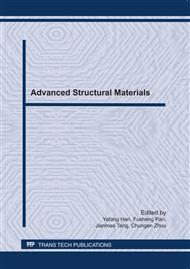p.623
p.630
p.637
p.641
p.646
p.654
p.661
p.671
p.678
Study on Microstructure of Laser In Situ Formation of TiBX and TiC Titanium Composite Coatings
Abstract:
Two kinds of mixed powders:Ti-6Al-4V/B/C and Ti-6Al-4V/B4C which are pre-pasted or synchronized fed on Ti-6Al-4V substrates separately were scanned by a 500W pulsed YAG laser to induce in situ formation of titanium composite coatings contained TiBx and TiC ceramic reinforced phases. The influences of laser processing parameters including Pulse Frequency (PF), Pulse Width (PW), Laser Power (P) and Scanning Speed (V) together with the powder proportions on the microstructure and properties of the coatings were investigated. Microstructures, phase components of the coating were analyzed by OM, SEM, TEM and XRD respectively. Experimental results show that two and more kinds of ceramic reinforcements were in situ formatted in the matrix of Ti-6Al-4V. TiB and TiC ceramics were formed evenly with the morphology of needle, tiny dendrites and disperse particles in the prepasted single path specimens. For the powder feed laser cladding layers, the ceramic reinforcements were TiB (needlelike), TiB2 (hexagonal prism or rodlike), a small amount of TiC (disperse particles) and non fully reacted B4C. The microhardness increased with the increase of the amount of B4C and B+C additions. When the added B and C contents are the same, the microhardness of the coating with B4C addition is higher than that of the coating with B+C addition. The average micro-hardness of a powder prepasted (with 20 wt.% B4C addition) multi-path laser cladding layer formed under the optimized processing parameters is up to 800HV, which is more than 2 times of that of the substrate (340Hv), and the wear weight loss of the layer decreased nearly 3 times that of the substrate.
Info:
Periodical:
Pages:
646-653
Citation:
Online since:
June 2011
Authors:
Keywords:
Price:
Сopyright:
© 2011 Trans Tech Publications Ltd. All Rights Reserved
Share:
Citation:


